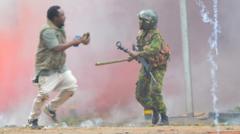Recent troop reductions in northeastern Syria highlight the changing political landscape following the Assad government's demise.
U.S. Troop Withdrawal Signals New Era in Syria's Recovery

U.S. Troop Withdrawal Signals New Era in Syria's Recovery
As President Assad's regime falls, the U.S. reassesses its presence amidst rising threats from the Islamic State.
The United States has initiated a significant withdrawal of troops from northeastern Syria, marking a pivotal change in the security situation in the region after the fall of President Bashar al-Assad in December. As part of this transition, the U.S. is closing three of its eight military bases, reducing the number of troops from approximately 2,000 to about 1,400, according to two senior U.S. officials.
The bases being shuttered include M.S.S. Green Village, M.S.S. Euphrates, and a smaller facility. Following a 60-day review period, U.S. commanders will evaluate the necessity for further troop reductions. It is recommended that at least 500 American personnel remain in Syria for ongoing operations.
While President Trump has expressed reservations about maintaining any military presence, particularly in light of recent developments, the decision to reduce troop levels is mainly rooted in recommendations from ground commanders. These adjustments have been vetted and approved by the Pentagon’s Central Command.
Despite the decrease in certain threats due to the regime's collapse, the Islamic State continues to pose a significant risk, particularly in the northeastern region where the U.S. forces are predominantly stationed. The end of Assad’s regime has also lessened other dangers, including those posed by Iranian-backed militias and Russian support for the Syrian government.
Last month marked another crucial shift when the Kurdish-led militia in northeastern Syria agreed to collaborate with the new government in Damascus, a step that facilitates consolidation in a nation still experiencing tumultuous activities.
The bases being shuttered include M.S.S. Green Village, M.S.S. Euphrates, and a smaller facility. Following a 60-day review period, U.S. commanders will evaluate the necessity for further troop reductions. It is recommended that at least 500 American personnel remain in Syria for ongoing operations.
While President Trump has expressed reservations about maintaining any military presence, particularly in light of recent developments, the decision to reduce troop levels is mainly rooted in recommendations from ground commanders. These adjustments have been vetted and approved by the Pentagon’s Central Command.
Despite the decrease in certain threats due to the regime's collapse, the Islamic State continues to pose a significant risk, particularly in the northeastern region where the U.S. forces are predominantly stationed. The end of Assad’s regime has also lessened other dangers, including those posed by Iranian-backed militias and Russian support for the Syrian government.
Last month marked another crucial shift when the Kurdish-led militia in northeastern Syria agreed to collaborate with the new government in Damascus, a step that facilitates consolidation in a nation still experiencing tumultuous activities.




















